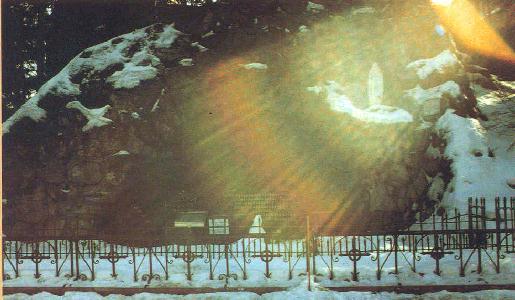
“Heavenly light” was the caption beneath this photograph of the Grotto published under the heading, Photo of the Week, in the South Bend Tribune on October 16, 1995.
These lines of explanation followed the caption: “Light streaming toward the Grotto at the University of Notre Dame creates a rainbow effect in this photograph by Richard L. Spicer of South 26th Street. He took the picture on a cold February morning.”
A conversation with Mr. Spicer produced more information about this most unusual photograph. Mr. Spicer said he was not a professional photographer. He had been a postal worker all his life. During the 1960's he also delivered newspapers part-time for the South Bend Tribune to several locations on the Notre Dame campus. One of those locations was Columba Hall across the road from the Grotto. During those trips to the campus he saw the Grotto many times.
Years later, in 1981, he purchased a Canon AE-1 35 mm camera with a 50 mm lens. He remembered how much he liked the Grotto and how he had always wanted a pretty picture of it. He decided to make a trip to the campus to try it out. About 8 AM, on a cold winter morning near the middle of February his wish finally came true. He captured this extraordinary photograph of the Notre Dame Grotto. It was the first picture he took with his new camera. He said he was not aware of the rainbow, or sun flare effect in the photograph, until the film was developed and when he first viewed the print of the photograph he couldn't believe it had happened. It was such a pretty picture.
The World Book Encyclopedia describes this occurrence when earth and heaven meet:
“The reflection and refraction of the sun’s rays as they fall on drops of rain cause this interesting natural phenomenon. ‘All the colors of the rainbow’ is an expression that means a brilliant display of color.
“The seven colors that appear in each rainbow are violet, indigo, blue, green, yellow, orange, and red. But these colors blend into each other so that the observer rarely sees more than four or five clearly. The amount of space each color takes up varies greatly and depends chiefly upon the size of the raindrops in which any particular rainbow forms. . . . As a ray from the sun passes into a drop of rain, the water acts like a prism. The ray is bent, or refracted, as it enters the drop, and is dispersed or separated into different colors.
“The people of Annam call a rainbow ‘little window in the sky.’ In central Europe it is called ‘the bridge of the Holy Spirit.’”
Mr. Spicer made these added observations of instances of serendipity revealed in his photograph. The Virgin Mary appears to be standing on a cloud and in the snow on the left side of the Grotto, the shape of a Dove, a symbol of the Holy Spirit, seems to be flying toward her.
However, Mr. Spicer, being non-Catholic, was unaware of yet another significant coincidence about his February photograph. Bernadette, the little French peasant girl, first saw the apparition of Mary at the grotto of Massabielle in Lourdes, France on February 11, 1858. That day in the middle of February is now known as Lourdes Day.
DVC
October, 1995
When Grotto Stories: From the Heart of Notre Dame was being compiled to commemorate the Grotto's Centenary, I suggested that Richard Spicer's photograph of a rainbow over the Grotto, because it was so special, be placed on the back cover. They were undecided until I explained that everyone who goes to the Grotto is looking for a rainbow experience -- a wish or prayer granted -- as it was for Richard.
Richard Spicer's wish for a pretty picture of the Grotto -- and his immediate reaction to his impulse to go to the campus on a cold February morning -- was answered in a most extraordinary way. My own rainbow experience was also the result of reacting spontaneously to a sudden impulse without really knowing why at the time. The result was such a wondrous experience that the delight of the moment expressed itself to me in intuitive verse something I had never done before. I share it here at the close of my journal because following that inner direction has been the driving force behind my research and the completion of this manuscript.
|
A Revelation in the Heart Heed your heart While you live It will lead you to the answer It will offer you comfort A direct line to God Here's the answer to your troubles D.Verne |
4-10-68
My first poem, at which time I realized that I carried within me the seed and the source of intuitive, untaught, non-inferential knowledge. Needing only to listen with my heart and follow it. My dictionary defines the word revelation as a "striking disclosure of something not before realized, the act of making known. A sudden perception of the essential nature or meaning of something."
Knowing nothing about poetry, this first poem affirmation -- though primitive and simple -- was the beginning of an interlude of illuminating verse. What I think of as talking to myself on paper -- listening for the voice of instruction directed at oneself -- and writing it down for future reflection.
Dr. David Foster, a scientist, put it this way: "God exists and communicates with mortals through images translated into thoughts and actions." A good example is this description of Walt Whitman. "Whitman was largely a self-educated journalist whose Self, at the top of its auto didactic voice, brought into poetry many of the ideas of his time."